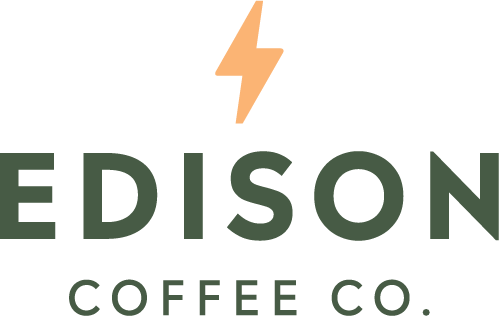Edison Coffee Brew Guide: Drip and Batch Brew
Drip coffee, or “batch brew”, is the term we use to describe coffee made in large quantities. You may be familiar with it as the coffee that you brew in the pot at home each morning! Though drip equipment can range from commercial-grade brewers to countertop coffee-pots, the principle of brewing is the same: Water is pumped out of a reservoir onto a bed of grounds. From there it is filtered through paper and drips into a large serving vessel.
The large batch size of drip coffee (which can range anywhere from 6 cups to 2 gallons) makes clarity and precision of flavor difficult to attain. If you want to create complex single-cup coffees, we’d recommend utilizing a pour-over method for your brewing. However, the convenience of drip coffee is undeniable, especially when brewing for a group. Additionally, just because a coffee is brewed in large amounts does not mean that its quality must be nullified. The steps to brewing drip coffee are simple enough, and understanding their place in the process should empower you to make adjustments as you wish in order to produce the best tasting cup possible. Join us as we take a look at how to brew excellent drip coffee!
Materials Needed
Brewer: This should be a no-brainer. What might be more difficult, however, is trying to decide which coffee machine should be used for your coffee brewing. We personally recommend Bona Vita’s 8-cup stainless steel brewer as an excellent coffee machine due to its imitation of pour-over parameters, but our principles will apply to any machine. Just make sure that your brewer is well-maintained and that all components work as they should!
Filters: Almost as a rule, batch brew coffee uses the standard-grade paper filters.
Grinder: Freshly ground coffee is non-negotiable when dealing with craft coffee. Coffee ages much quicker once it is ground, which can drastically affect the quality of lighter-roasted beans, whose natural flavors offer more complexity than darker roasts. We recommend burr grinders over blade grinders due to their ability to achieve high consistency. Grinders such as the Baratza Encore may require a higher investment on the front end, but the sharp increase in quality is not only noticeable: it makes reverting back to a blade grinder seem like an impossible notion!
Scale: Any scale that can measure grams, ounces, and/or milliliters will work!
Water: We recommend using filtered water for your brewing if you have access to it. The flavor of the coffee will emerge much more clearly without the impurities and unwanted minerals common in simple tap water.
Coffee: Perhaps you want the balanced taste of our blends to get you started in the morning; maybe you want to share the wild flavors of one of our single origin offerings with your friends at a dinner party. The choice is yours. We love trying out single-origin coffees on the coffee pot, but we recommend giving our blends a glance, first and foremost. While we develop our SOs to be primarily enjoyed on pour-overs and in espresso, we curate our blends with batch brew in mind. As such, blends such as Phonograph and Frequency promise the most consistent quality for your machine.
Instructions
Weigh out your coffee and fill coffee reservoir with water:
Most coffee pots should have indicators for the number of cups (8 fl. oz) it can hold. We recommend using 75 grams of ground coffee 1.3 liters of water for a full pot (64 ounces). For half a pot, measure out 37.5 grams of coffee and 650ml. A full pot can fill about 5 12oz mugs; a half pot, about 2 and a half.
75 grams of coffee for every 1.3 liters of water is a coffee-to-water ratio of 1:17. This is because 1.3 liters is equal to 1300 milliliters, which is equal to 1300 grams. If you have a scale and want to experiment with different batch sizes, take your desired dose of coffee and multiply it by 17. The final number will be the amount of water necessary for your batch.
Grind desired amount of coffee:
Generally speaking, the goal is to achieve a medium grind for drip coffee. Specific parameters may vary depending on your coffee and grinder, so a basic visual reference may be useful. The coffee should be about as coarse as sand.
Place coffee in the filter, insert filter into the machine, and press “brew”:
And… That’s it! Sit back, let the coffee pot work its magic, and give yourself a pat on the back.
Troubleshooting:
If your coffee tastes funky, there are typically two possible solutions: Adjust your grind or adjust your dosage. When your grind is too coarse, it yields an under-extracted batch of coffee that tends to taste sour and acidic and should be made finer. Conversely, a grind that is too fine yields over-extracted coffee, which tastes sharply bitter and empty. Coarsen your grind accordingly. If adjusting your grind doesn’t fix the issue, try adjusting the amount of coffee you are brewing with. More ground coffee will yield a stronger brew while less ground coffee will yield a lighter, more watery brew.
Conclusion:
Batch Brew Coffee is the best option when making coffee for a large group, or for when you need multiple cups to grind through a project. Despite its straightforward nature, there is still plenty of room to improve the quality of your cup, from the beans that you choose to adjust your desired strength. We hope that you are able to curate your coffee to your satisfaction and that it warms many a hearts within your household.




